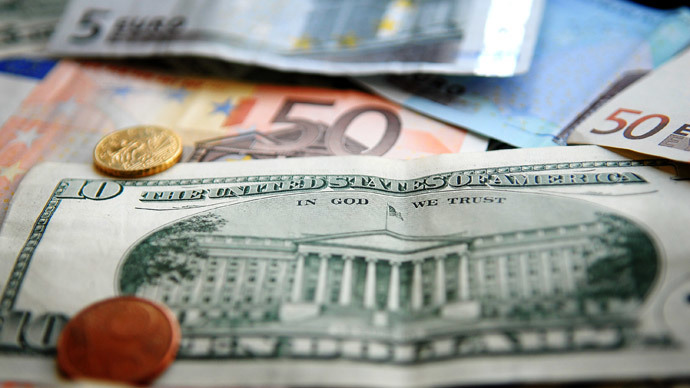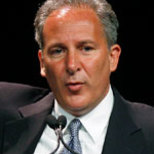– Meet ‘lowflation’: Deflation’s scary pal (RT, April 7, 2014):
In recent years a good part of the monetary debate has become a simple war of words, with much of the conflict focused on the definition for the word “inflation.”
Whereas economists up until the 1960’s or 1970’s mostly defined inflation as an expansion of the money supply, the vast majority now see it as simply rising prices. Since then the “experts” have gone further and devised variations on the word “inflation” (such as “deflation,” “disinflation,” and “stagflation”). And while past central banking policy usually focused on “inflation fighting,” now bankers talk about “inflation ceilings” and more recently “inflation targets”. The latest front in this campaign came this week when Bloomberg News unveiled a brand new word: “lowflation” which it defines as a situation where prices are rising, but not fast enough to offer the economic benefits that are apparently delivered by higher inflation. Although the article was printed on April Fool’s Day, sadly I do not believe it was meant as a joke.
Up until now, the inflation advocates have focused their arguments almost exclusively on the apparent dangers of “deflation,” which they define as falling prices. Despite reams of evidence that show how an economy can thrive when prices fall, there is now a nearly universal belief that deflation is an economic poison that works its mischief by convincing consumers to delay purchases. For example, in a scenario of 1% deflation, a consumer who wants a $1,000 refrigerator will postpone her purchase if she expects it will cost only $990 in a year. Presumably she will just make do with her old fridge, or simply refrain from buying perishable items for a year to lock in that $10 savings. If she expects the cost of the refrigerator to decline another 1% in the following year, the purchase will be again put off. If deflation persists indefinitely they argue that she will put off the purchase indefinitely, perhaps living exclusively on dried foods while waiting for refrigerator prices to hit zero.
Economists extrapolate this to conclude that deflation will destroy aggregate demand and force the economy into recession. Despite the absurdity of this argument (people actually tend to buy more when prices fall), at least there is a phantom bogeyman for which to conjure phony terror. Low inflation (below 2%) is even harder to demonize. Few have argued that it has the same demand killing dynamics as deflation, but many say that it should be avoided simply because it is too close to deflation. Given their feeling that even a brief bout of minor deflation could lead to a catastrophic negative spiral, they argue for a prudent buffer of 2% inflation or more. But the writer of the Bloomberg piece, the London-based Simon Kennedy, quotes people in high positions in the financial establishment who offer new arguments as to why “lowflation” (as he calls it) is a “threat” in and of itself. And although the article was primarily concerned with Europe, you can be sure that these arguments will be applied soon to the situation in the United States.
The piece correctly notes that those struggling with high debt tend to welcome high rates of inflation. The math is simple. By diminishing the value of money, inflation benefits borrowers at the expense of lenders. By repaying with money of lesser value, the borrowers partially default, even when paying in full. The biggest borrowers in Europe (and the United States for that matter) are heavily indebted governments and the overly leveraged financial sector. Should it come as a surprise that they are the leading advocates for inflation? The writer admits that higher inflation will help these interests manage their debt burdens and in the case of the financial sector, profit from the increased lending that low interest rates and quantitative easing encourage.
On the other side of the ledger are the consumers, the savers, and the retirees. These groups want lower prices and higher rates of interest on their accumulated capital. Such a combination will lead to higher living standards for those who have worked and saved for many years in order to enjoy the fruits of their efforts. But these types of people are simply not on the “must call” list for our best and brightest economic journalists. As a result, we only get one side of the story.
The article also points out that higher inflation gives businesses more flexibility to retain workers in periods of weak growth. The argument is that if sales revenue falls, companies will not be able to lower wages, and will instead resort to layoffs to maintain their profitability. However, this is only true in cases involving labor union contracts or minimum wage workers. In all other cases, business could reduce wages in lieu of layoffs. Plus, if prices for consumer goods are also falling, real wages may not even decline as a result of the cuts.
In circumstances where wages cannot be legally reduced, as is the case for unionized or minimum wage workers, layoffs are often the employer’s only option for keeping costs in line with revenue. However, inflation allows employers to do an end run around these obstacles. In an inflationary environment, rising prices compensate for falling sales. The added revenue allows employers to hold nominal wage costs steady, even when the raw amount of goods or services they sell declines. When inflation rages, higher skilled workers will often demand, and receive, pay raises. But low-skilled workers, who lack such leverage, are usually left holding the bag.
In other words, politicians can impose a high minimum wage to pander to voters, but then count on inflation to lower real labor costs, thereby limiting the unemployment that would otherwise result. So what the government openly gives with one hand, it secretly takes away with the other. Workers vote for politicians who promise higher wages, but those same politicians also create the inflation that negates the real value of the increase. But while government takes the credit for the former, it never assumes responsibility for the latter. The same analysis applies to labor unions. Based upon political protection offered by friendly officials, unions can secure unrealistic pay hikes for their members. But the same governments then work to reduce the real value of those increases to keep their employers in business.
Of course, what the Bloomberg writer was really arguing is that governments need inflation to bail themselves out of the policy mistakes they make to secure votes. But two wrongs never make a right. The correct policy would be to run balanced budgets rather than incur debts that can only be repaid with the help of inflation. On the labor front, the better policy would be to abolish the minimum wage and the special legal protections offered to labor unions, rather than papering over the adverse consequences of bad policies with inflation.
So be on the lookout for any more hand-wringing over the supposed dangers of lowflation. The noise will simply be an effort to convince you that what’s bad for you is actually good. And although it’s an audacious piece of propaganda to even attempt, the lack of critical awareness in the media gives it a fighting chance for success.
Peter Schiff is the CEO and Chief Global Strategist of Euro Pacific Capital, best-selling author and host of syndicated Peter Schiff Show.

